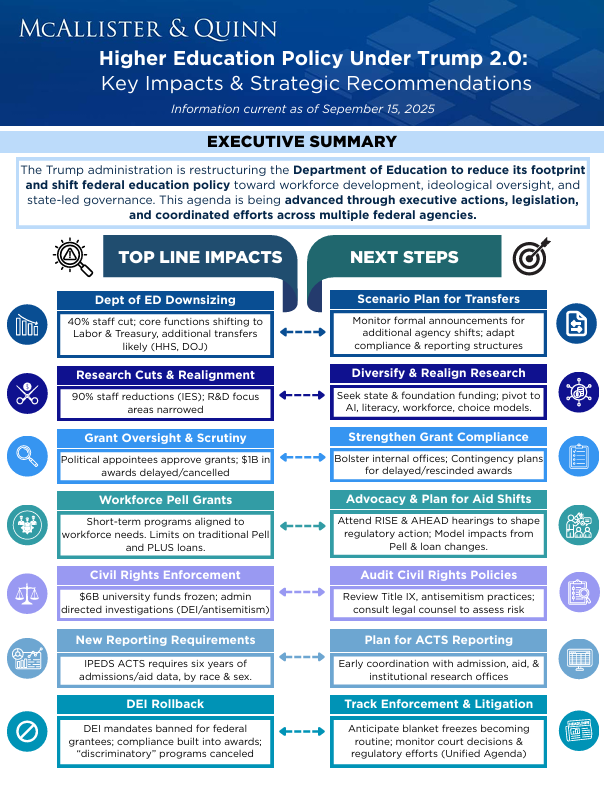
A Shutdown and a Shifting Policy Landscape
On Wednesday, October 1st, 2025, both Republican and Democratic proposals to keep the government open and funded, failed, marking the 15th government shutdown since 1981. This is currently the second-longest shutdown in US history. This shutdown places many colleges and universities in a state of uncertainty, during a time when higher education policy shifts are already in flux.
Understanding the current and planned efforts taken by the Trump administration to reshape the higher education landscape in his second term is crucial, from policy priorities to the administration’s implementation of them. These efforts are expected to influence how institutions plan, compete for federal funding, and align with national workforce and economic goals. As these dynamics continue to unfold, particularly amid the ongoing government shutdown and budget uncertainty, colleges and universities should be attentive to several key areas of impact.
Key Impacts on Higher Education
While the government is shut down, it’s crucial for institutions of higher education to stay proactive and consider alignment of their strategic planning, communications, and funding pursuits with the administration’s evolving priorities. Here are some of the top line impacts and next steps for institutions of higher education to consider and stay competitive:
- Reducing the Scope of the Department of Education: The administration is actively pursuing a strategy to reduce the size and capacity of the Department of Education (ED) while realigning its activities to advance key policy priorities.
- Next steps: Institutions should monitor formal announcements for additional agency shifts and adjust to changes to compliance and reporting requirements accordingly.
- Expanding Oversight of Federal Grantmaking: Prior to the shutdown, competitive federal grant awards were already being delayed or canceled. The administration has attempted to increase the power of political appointees over funding decisions, limit indirect costs, and expand termination authority through executive actions. These temporary changes may likely be codified when the Uniform Guidance is revised. For more information, click here to read President Trump’s Executive Order (EO) on Improving Oversight of Federal Grantmaking.
- Next Steps: Institutions should strengthen grant compliance offices and develop contingency plans for delayed or rescinded awards.
- Prioritizing Workforce Development: The Department of Education released a new grantmaking priority, “Career Pathways and Workforce Readiness,” to “support career and technical education and work-based learning opportunities integrated into K-12 systems and higher education.” The Department of Education, Department of Commerce, and Department of Labor collaborated on a workforce development plan released in August, titled “America’s Talent Strategy: Building The Workforce for the Golden Age.”
- Next steps: Institutions should evaluate what existing or new programs could be good candidates for funding under these new priorities.
- Funding Priority Agreements: In the coming months, the Department of Education is expected to attempt tying federal dollars to adherence to administration priorities. On October 1st, the Department sent a 10 point memo to 9 high profile universities, encouraging agreement on a series of expectations on the administration’s goals for higher education, including freezing tuition for five years, banning diversity, equity, and inclusion (DEI) programs, and encouraging viewpoint diversity. As of the October 20 decision deadline, 7 of the 9 schools rejected the administration’s terms outright.
- Next steps: Institutions should review and understand the compact and discuss internally how to move forward, should these agreements become more widespread.
What Colleges and Universities Should Do Now
For a clear breakdown of the administration’s higher education priorities, impacts, and next steps your institution should take, download our one-page executive summary.
Key Impacts & Strategic Recommendations
Note, this information is subject to change quickly.
McAllister & Quinn’s Strategic Intelligence Support
Shutdowns may be temporary, but their effects can last far longer. McAllister & Quinn is committed to helping colleges and universities turn strategic intelligence into action, ensuring they are prepared to meet today’s challenges and respond with agility. Our team closely monitors legislative actions, executive orders, and regulatory updates so that institutional leaders are equipped with timely insights to inform decision-making.
For more information about our strategic intelligence services, including tracking and monitoring of the federal budget and appropriations cycle, and how emerging policy shifts may impact your institution’s funding, compliance, and strategic planning priorities, contact the McAllister & Quinn team today.

Micaela Quinn
Micaela Quinn is a Director of Grants and Federal Affairs in the Higher Education Practice at McAllister & Quinn. She specializes in helping small to mid-sized colleges and universities navigate the evolving federal funding landscape.

Lena Heier
In her role as a Higher Education Research Analyst, Lena Heier supports Directors and Managing Directors by identifying and researching federal and foundation funding opportunities for clients.

Maddie FitzGerald
Maddie FitzGerald serves as a Research Analyst for McAllister & Quinn. In this role, Maddie conducts in-depth policy and legislative analysis, tracks federal funding opportunities, and develops strategic research products tailored to client priorities.


